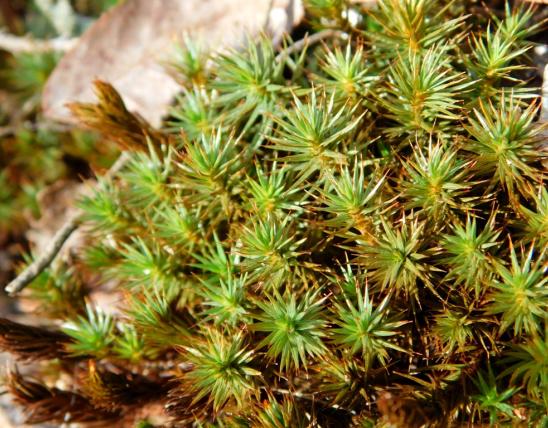
Pincushion mosses, also called white mosses (Leucobryum spp.), are strikingly whitish green and form thick, dense, pillowlike mounds that may be the size of a pincushion or much larger. Look for them on thin soils of ridges and rock ledges. Missouri has two species, which look quite similar.
As a genus, these common mosses are easy to identify at a glance based on the color, texture, growth form, and habitat. Looking more closely, you will see that the leaves are long, thick, tubular at the base, and tapered at the ends. The stems are upright, crowded, and are often up to 6 inches high.
The top layer(s) of cells of the leaves are clear, which makes these mosses look pale. When the moss is wet, those clear cells hold water, and the lower/inner layer of green cells is more visible, making the moss look darker green.
Sporophytes are not very common in this genus. When they occur, they arise from the tips of the stems. The capsule is held upright or inclined on a slender stalk. The capsules mature in autumn.
Learn more about Missouri’s mosses on their group page.
There are only two species in this genus in North America (and Missouri). If you find a small Leucobryum on an oak-hickory ridge, you may have trouble distinguishing between the two. Here are some tips:
- Leucobryum glaucum is very common in the Ozarks, especially on rocky ledges with acidic soils. Its cushions may be large, to 1 foot wide or more; the stem height is 1–5 inches or more. It has leaves 3–9 mm long. Specialists measure the two parts of the leaves (the sheath, which is the base that clasps the stem, and the limb, which is the outer, free extension of the leaf); in L. glaucum, the limb is 1–2 times longer than the length of the sheath. L. glaucum rarely forms sporophytes.
- Leucobryum albidum is likewise common in high, dry situations, commonly in the Ozarks, on soils at the bases of trees and rock ledges. Its cushions are smaller and shorter, only a few inches in diameter and about a half inch tall. The leaves are only 2–4 mm long, and the leaf limb is usually shorter than the sheath. Frequently forms sporophytes.
A closer look: Specialists may also use microscopes to count the cell layers at the midribs at the base of the leaf, with L. glaucum having more layers (4 or 5) than L. albudum (3 layers). That is, L. glaucum’s leaves are thicker than those of L. albidum. But using the ratio of sheath and limb lengths, described above, is easier and more reliable.
Similar species: Members of genus Leucobryum look a lot like the many Bryum species, except for the whitish color — something like the color of celery.
Width: the cushion-like tufts commonly range from a few inches to 1 foot in diameter.
Statewide, in appropriate habitats.
Habitat and Conservation
Leucobryum mosses occur on dry soil or rock, but moist areas are also possible. They are most common on thin soils of ridges and rock ledges in open, upland woodlands. These rather high and dry habitats are unlike those of more typical mosses, which require low, moist places.
Often, L. glaucum occurs alongside juniper haircap moss (Polytrichum juniperinum) and broom or fork mosses (Dicranum). Its common substrates include granite, sandstone, and dolomite.
Life Cycle
Leucobryum glaucum does not commonly produce sporophytes (spore-bearing offspring plants), though L. albidum frequently does.
These mosses commonly reproduce vegetatively when a portion of the plant breaks away, gets moved elsewhere, and continues growing as a separate plant.
Indeed, these mosses frequently become dislodged or scratched loose by crows, game birds, squirrels and other rodents, or other small animals. Deer overturn the cushions as they walk around. Even the wind, or simple gravity on a slope, can roll a loose ball of moss to another location. These mosses are apparently adapted to being uprooted and moved, because once they stop rolling, they can put down new rootlike rhizoids from just about any part of the plant. Then the moss can grow again and establish a new population.
Human Connections
Leucobryum mosses are some of the most popular mosses cultivated in gardens. Undulating mounds of these dense, firmly packed, velvety-looking mosses are a breathtaking sight.
The word glaucous comes up a lot in botany, as it does in the species name glaucum. It refers to a whitish, waxy coating that occurs on a variety of plant surfaces, that usually can be rubbed off. Think of the whitish coating on grapes or plums. The word glaucoma has the same root; it refers to the whitish-gray, cloudy appearance of the eye that occurs as that disease progresses.
The other species name, albidum, means “white” in Latin. The genus name, Leucobryum, means “white bryum,” or “white moss” (leuco- meaning “white” in Greek; bryum meaning “moss”).
Ecosystem Connections
The thick cushions of leucobryum mosses are perfect microhabitats for a variety of small invertebrates, including springtails and an order of little-studied mites called oribatid mites or moss mites. The micro-scale habitats created by mosses and other small plants and animals are fascinating and deserve further study.
Several species of salamanders commonly hide beneath cushions of mosses, and pincushion mosses are an example.
Apparently, Leucobryum glaucum contains toxic substances that deter herbivorous insects such as some moth caterpillars.










Mosses, liverworts, hornworts, and lichens seem rather similar, but these organisms are in very different groups. Mosses, liverworts, and hornworts are small, low plants usually found in damp habitats. Unlike more familiar plants, they lack veinlike structures and do not produce flowers or seeds — instead, they produce spores. Meanwhile, lichens are not plants at all: they are a collection of different fungi that have photosynthetic algae living within their tissues.































